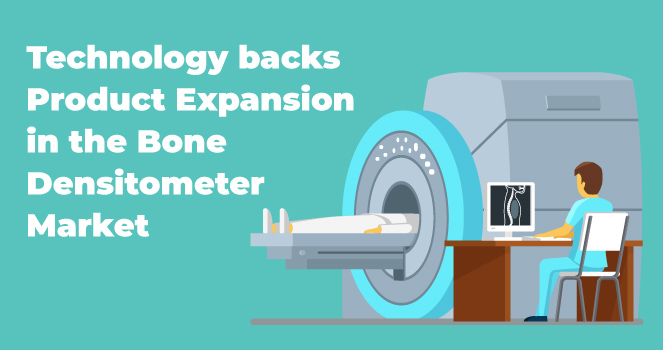



05, May 2022

The world’s population continues to age, making them susceptible to bone-related ailments. From the increasing risk of osteoporosis and bone fracture, elderly people majorly experience health issues that have contributed to the growth of bone densitometer devices.
The bone densitometer market has witnessed a significant expansion over the years. The rise in degenerative joint diseases among older people has increased the demand for axial bone densitometer technology and DXA scanners supplementing the overall market. For instance, Medilink and Beammed Ltd provide axial technology that ensures the measurement of osteoporotic fractures.
Based on our study, the global bone densitometer market will advance at a CAGR of 4.66% from 2022 to 2028. However, the lack of public awareness about osteoporosis as a major health problem hinders the market’s demand. The risk factors associated with the emission of radiation from the densitometer have also impacted its adoption progression.
Some prominent companies operating in the global market are Osteometer Meditech Inc, G.E. Healthcare, Hologic Inc, L’CAN L’Accessorio Nuclear S.R.L., O.S.I. Systems Inc, and Eurotec Systems S.R.L.
The global bone densitometer market analysis is studied based on key segmentation technology, end-user, and application.
Axial bone densitometry captures the largest share in the technology segment.
It is a simple, non-invasive, and quick method used for diagnosing osteoporosis. Robust development of technology and the rising number of patients with osteoporosis have led to the segment’s growth.
The end-user segment is driven due to hospitals, specialty clinics, and other end-users.
Over the years, the end-users, especially hospitals and specialty clinics, compare densitometer devices according to their drawbacks and cost. It has prompted companies to invest in R&D to expand the use of devices. For example, Trivitron Healthcare provides advanced digital DXA detectors exclusively designed to get precise measurement results.
Osteoporosis contributes significantly to the growth of the bone densitometer market owing to the rise in the number of people with degenerative diseases. The deficiency of vitamin D, calcium, magnesium, minerals, and other vitamins leads to the growth of osteoporosis. As a result, many prominent players in the market are working towards expanding their product line in bone densitometer devices.
The prevalence of cystic fibrosis, especially in women, has resulted in the demand for DXA scanners to identify the patient’s bone density. As a result, increased CF in people has created traction for bone densitometer devices.
Rheumatoid arthritis is an autoimmune disease and is most common in older people. The growing global incidence of joint pain and change in bone density has influenced the market’s growth. With the rising number of women affected by rheumatoid arthritis, there is a growing demand for axial densitometer technology to treat the patients.
While researchers and clinicians use DXA technology to evaluate their patients’ body and bone composition measurements, its adoption is expected to increase the market for bone densitometer devices.
According to the global scenario, the market is segregated into countries across regions to study its performance and prospects.
Asia-Pacific has growth potential over the forecast period 2022-2028 and is likely to advance at a CAGR of 5.22%.
India and China are likely to emerge as the fastest-growing countries in the Asia-Pacific bone densitometer market. The robust growth can be attributed to the increased geriatric population. Besides, the government takes effective initiatives to organize awareness programs related to osteoporosis, thus influencing the growth of bone densitometer devices.
North America is the leading market for bone densitometers and is estimated to grow at a CAGR of 10.97% in the estimated period from 2022 to 2028.
The presence of many end-users has influenced the market’s performance in the region. Moreover, the adoption of modern technology by big players such as Cardinal Health Inc., contributes to the regional market.
The prevalence of osteoporosis and other degenerative diseases due to the rising geriatric population has influenced the market’s growth. To increase the awareness among its users, market players are improving the performance of these devices through R&D and technological advancements such as the development of DXA scanners. As the risk of osteoporosis increases with age, it is likely to generate a profitable market for bone densitometer devices in the upcoming years.
Our estimates indicate global bone densitometer market to earn revenue worth $1321.36 million by 2028.
The consistent and innovative advancements in technology, such as the introduction of DXA scanners, integrated digital detectors, and ultrasound densitometers, are some opportunities in the market.

Prevalent cases of terrorist attacks in today’s world is increasing the need for severe standards of security for public safety, and the global market for biometric technology scrupulously accommoda..
Prevalent cases of terrorist attacks in today’s world is increasing the need for..